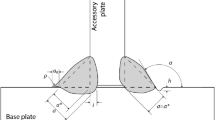Abstract
In the case of structural weldments, the procedure for estimating fatigue life requires information concerning geometry of the object, loads, and material. Detailed knowledge of stress fields in the critical regions of weldments is used to determine the fatigue life. The main theme of the research discussed in this paper is to provide details of the methodology which has been developed to determine the peak stress and associated non-linear through-thickness stress distribution at the critical weld toe crack plane by using only the geometry-dependent stress concentration factors along with appropriate unique reference stress calculated in an efficient manner, e.g., without modeling geometrical weld toe details. The peak stress at the weld toe can be subsequently used for estimating the fatigue crack initiation life. The non-linear through-thickness stress distribution and the weight function method can be used for the determination of stress intensity factors and for the analysis of subsequent fatigue crack growth. Accurate peak stress estimation requires 3D fine mesh finite element (FE) models, accounting for the micro-geometrical features, such as the weld toe angle and weld toe radius. Such models are computationally expensive and therefore impractical. On the other hand, stresses at the sharp weld corners obtained from 3D coarse FE meshes are inaccurate and cannot be used directly for fatigue life estimations. This paper describes a robust, sufficiently accurate, and efficient stress analysis method for fatigue life estimation of welded structures based on 3D FE coarse mesh models. Another objective is to establish a methodology which is capable of accounting for the actual variability of stress concentration factors at welds, welding defects such as misalignment, and incomplete penetration resulting from the manufacturing process. The methodology described in the paper has been validated by analyzing several weldments of varying geometrical and load configurations. The proposed methodology not only reduces conservative fatigue design of welded structures but also leads to significant savings concerning modeling and computation efforts.






















Similar content being viewed by others
References
Glinka G (2011) Fatigue & fracture mechanics. University of Waterloo, Lecture Notes
Chattopadhyay A, Glinka G, El-Zein M, Qian J, Formas R (2011) Stress analysis and fatigue of welded structures. Weld World 55(7):2–21
Mikheevskiy G, Glinka S (2009) Elastic–plastic fatigue crack growth analysis under variable amplitude loading spectra. Int J Fatigue 31:1828–1836
Radaj D, Sonsino CM, Fricke W (2006) Fatigue assessment of welded joints by local approaches, 2nd edn. Woodhead Publishing, Cambridge
Fricke W (2003) Fatigue analysis of welded joints: state of development. Mar Struct 16:185–200
Niemi E (1995) Stress determination for fatigue analysis of welded components, Doc. IIS/IIW-1221-93, Abington Publishing, Cambridge, UK
Fricke W (2002) Recommended hot-spot analysis procedure for structural details of ships and FPSOs based on round-robin FE analysis. Int J Offshore Polar Eng 12(1):40–8
Hobbacher AF (2009) The new IIW recommendations for fatigue assessment of welded joints and components—a comprehensive code recently updated. Int J Fatigue 31:50–58
Radaj D, Sonsino CM, Fricke W (2009) Recent developments in local concepts of fatigue assessment of welded joints. Int J Fatigue 31:2–11
Monahan CC (1995) Early fatigue cracks growth at welds. Computational Mechanics Publications, Southampton
Iida K, Uemura T (1996) Stress concentration factor formulas widely used in Japan. Fatigue Fract Eng Mater Struct 19(6):779–786
Goyal R, Glinka G (2013) Fracture mechanics based estimation of fatigue lives of welded joints. Weld World 57(5):625–634 (ex IIW Document XIII-2413-12, 2012)
Author information
Authors and Affiliations
Corresponding author
Additional information
Recommended for publication by Commission XIII - Fatigue of Welded Components and Structures
Rights and permissions
About this article
Cite this article
Goyal, R., El-Zein, M. & Glinka, G. A robust stress analysis method for fatigue life prediction of welded structures. Weld World 60, 299–314 (2016). https://doi.org/10.1007/s40194-016-0295-y
Received:
Accepted:
Published:
Issue Date:
DOI: https://doi.org/10.1007/s40194-016-0295-y




